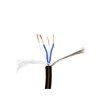I have some Canare L-4E6S Star Quad cables and I want to make two RCA cables to connect a subwoofer to my system. I looked in various other audio forums but none were clear enough on how to do this properly.
The Canare L-4E6S cable has two white wires, two blue wires and a shield. The connectors I want to use are by amphenol. I was thinking that I could solder the two white wires in the center (I think they call it a solder cup) and the two blue wires on the inside of the cable clamp. I posted a picture below showing where I was thinking the wires should be soldered.
But the question is what do I do with the braided shield, where do I solder it?
If someone can answer this and maybe include a picture of where all the wires should be soldered for a proper connection I think it will help many others who are starting out and are looking to do something similar.

The Canare L-4E6S cable has two white wires, two blue wires and a shield. The connectors I want to use are by amphenol. I was thinking that I could solder the two white wires in the center (I think they call it a solder cup) and the two blue wires on the inside of the cable clamp. I posted a picture below showing where I was thinking the wires should be soldered.
But the question is what do I do with the braided shield, where do I solder it?
If someone can answer this and maybe include a picture of where all the wires should be soldered for a proper connection I think it will help many others who are starting out and are looking to do something similar.

